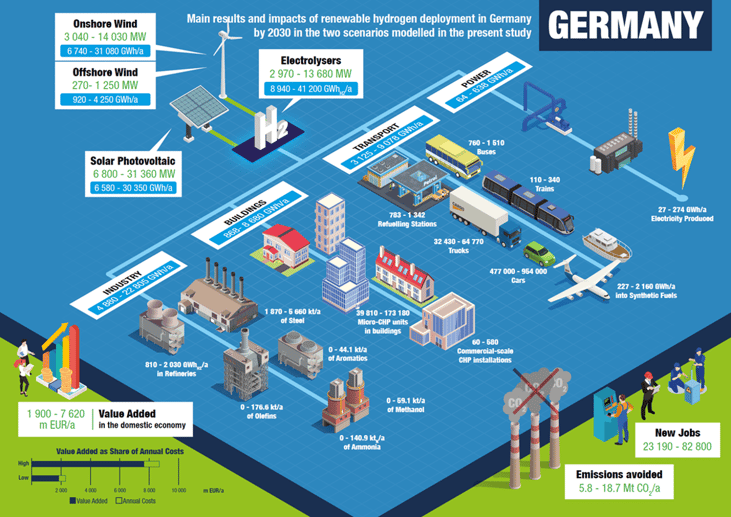- Olga Schmidt
- 12.12.25
- 2 min
- Success factor sustainability
Your contact person
Dr Günter Hohmann
Hydrogen is an important energy carrier of the future and a fundamental component of the global energy transition. With the National Hydrogen Strategy, the German government has created a framework for action to accelerate the transition from a fossil-based energy economy to a hydrogen-based energy economy in Germany. The focus here is primarily on electrolysis, which can provide green hydrogen from water using electricity from renewable energies.
Although hydrogen is the most common chemical element in the universe, it is hardly present in elemental form (as an H2 molecule) on Earth. The H2 molecule is an excellent energy carrier: it is not harmful to the environment and forms water as part of an oxidation process. This process can be used either electrochemically (fuel cell) or thermally (combined heat and power plant) to generate electricity.
For the environmentally compatible production of hydrogen, electricity can be used to split water into hydrogen and oxygen. The electricity used for production should come from renewable sources (photovoltaics, wind energy, hydropower), otherwise the environmentally friendly character is lost.
Fossil-produced hydrogen is already used around the world in a variety of different processes, such as in ammonia production using the Haber-Bosch process or for the hydrogenation of organic molecules, e.g. pharmaceuticals. On a large scale, however, this hydrogen is mainly obtained through the combustion of natural gas. In this context, approaches are also being researched to obtain natural gas-like compounds from waste materials such as plastics, sewage sludge or liquid manure and to produce hydrogen from them through heterogeneous catalytic reactions.
Differences between the types of hydrogenA hydrogen-based energy economy requires large amounts of renewable energy to enable the operation of electrolysers for hydrogen production in addition to meeting other electricity needs. By producing and storing hydrogen during energy peaks (photovoltaic daytime), the energy is stored in order to make it usable in the event of an energy lull (photovoltaic nighttime).

Source: FCHJU, 2020
In addition to the development of renewable energies, an expansion of electrolyser and storage capacities for hydrogen is also needed to meet this demand.
It is assumed that the hydrogen demand for Germany in 2030 corresponds to an electrolyser capacity of 9,000-40,000 GWh. To meet this demand, an electrolyser capacity of 1-5 GW is needed with an annual operating time of 4,000 hours. For the year 2050, in which CO2 neutrality is to be achieved, a significantly higher hydrogen demand of 250,000-800,000 GWh is expected in Germany.
Due to different circumstances, the local possibilities for generating renewable energy and, accordingly, for electrolysis, will differ greatly. This means that a national hydrogen transport system will be needed to meet local demand. In addition, the seasonal fluctuations in electricity production and consumption must also be considered and an international supply system planned. Transport at the national level can be achieved by retrofitting the existing natural gas pipeline network. However, the other properties of hydrogen must be taken into account. On the one hand, hydrogen is a much smaller molecule than methane, which leads to an increased risk of leakage, and on the other hand, material wear due to hydrogen corrosion must be taken into account.
For international transport, there is the additional hurdle that the cost of storing large quantities of gases increases exponentially. This means that large quantities of hydrogen cannot be transported in gaseous form. An alternative would be to liquefy the hydrogen, but this requires the hydrogen to cool down considerably. During transport, however, the hydrogen would heat up again and thus evaporate again. In order to reduce the associated pressure increase, vaporised hydrogen must be continuously drained, which leads to a loss of hydrogen.
The conversion of hydrogen into derivatives that can be stored and transported, such as methanol or ammonia, can be used to enable the long-range transport of hydrogen.
Promotion of hydrogen projectsHydrogen and hydrogen-related technologies are currently enjoying extensive promotion at both national and international level. |
||
If you have any questions or are interested in the topic of hydrogen, please feel free to contact us at any time or visit our hydrogen page. EurA has gained extensive experience with the above-mentioned funding programmes in recent years. Are you interested and would like to learn more? Then please contact us and we will support you in your application process.
Author: Georg Beckmann

Your contact person
Dr Günter Hohmann
EurA AG
T- 079619256-0Max-Eyth-Straße 2
73479 Ellwangen
info@eura-ag.com